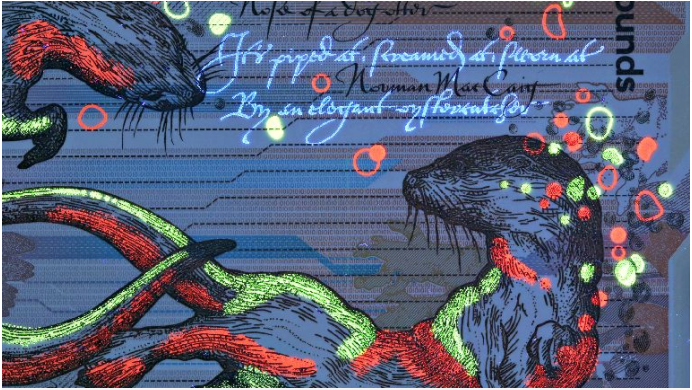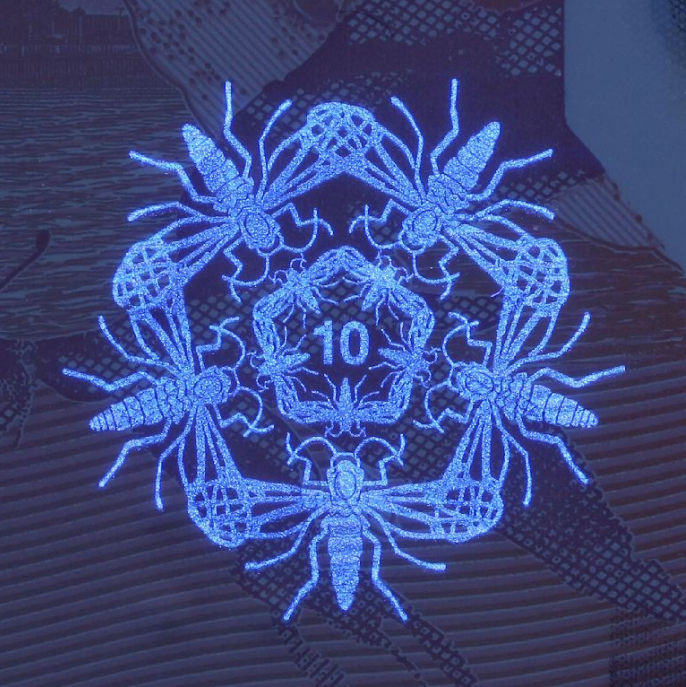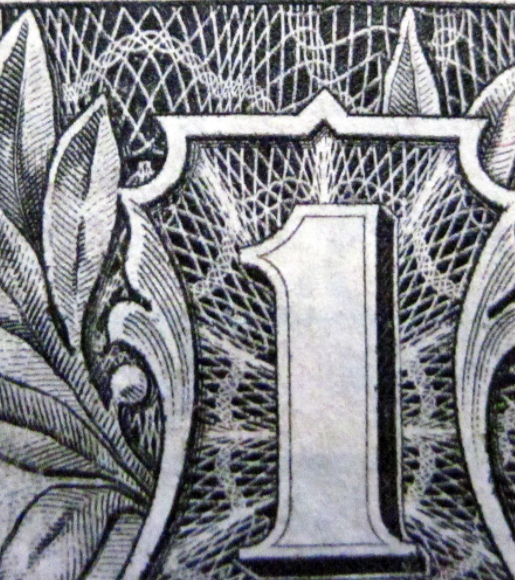Today, a new edition of the £10 enters circulation. Another £10 note, you say? Didn’t the Jane Austen one just get released?
You’re quite correct. But that was the Bank of England’s new tenner.
In Scotland, the Royal Bank of Scotland (RBS), Clydesdale Bank and the plain ol’ Bank of Scotland can all issue banknotes. And following the Bank of England’s lead, they are slowly phasing out their cotton paper notes in favour of plastic ones. Slow enough, in my opinion, that we might not ever see a plastic £50 note – but more on that tomorrow.
Taking a look at what my old friends up north will be buying booze with, I was really quite taken with the security features embedded into the design. All UK banknotes have hidden elements of their design that can only be viewed under ultraviolet light, but I’d not seen anything quite like this before:
 Source: STV
Source: STV
The verse of poetry revealed in blue (written by Norman MacCaig) is invisible to the naked eye.
Can you see the “10s” on the otters’ noses?
And that’s just the back. The front of the note bears the image of the polymath, Mary Somerville; under an ultraviolet lamp you can see a geometric diagram of the moon she drew, along with a third otter and a… swarm of bloodsucking midges.
 Source: STV
Source: STV
Apparently the midges are symbolic of life in the Scottish countryside… I think they could have done better. But it’s certainly original.
And it makes for some great metaphors. Like midges, fiat currency inflation is a nuisance, and it too is swarming at a rate of 3% a year, sucking the blood from the citizenry. I’m sure somebody will make a comparison to vampiric banking elites sucking the life out of the populace.
Reminds me of the owl hidden on the American $1 bill. Nestled on the top left of the “1” on the bill, the tiny owl peeks out. What is it doing there?

Conspiracy theorists see it as the calling card of Bohemian Grove, the private members club (or secret society, some would say) for the rich and powerful, which has a giant statue of an owl on its Californian estate.
Grove members have gone on to become US presidents, heads of industry and directors of the Federal Reserve. They have printed an owl on the dollar, the theorists say, as a symbol of ownership – for they own the Federal Reserve and control the US from the shadows.
If you know of any Scottish secret societies with a midge as their symbol, let me know.
Of course, the owl may just be a printing anomaly. Or maybe it’s just a security feature they never told anybody about.
Conspiracies aside, I’m impressed with the new tenner – paper money hasn’t looked quite this good for a while. I’ll be on the lookout for these next time I visit home.
Don’t get me wrong – I’m no fan of fiat currencies (and I’m certainly no fan of RBS, who is issuing this new note), but looking at its extensive list of security features made me reflect.
New money and old money
Hard currency advocates – those who advocate for a return to the gold standard or something similar – sometimes zealously claim that paper currency is “worthless”, or equivalent to toilet roll.
But a currency that is hard or impossible to forge, yet easy to verify, has a utility value, even if it is made from inexpensive materials, like polymer.
Checking the new polymer notes to be sure of their validity is much easier than checking if a gold or silver bar is real, or as pure as the owner says it is. A common and inexpensive way of testing gold and silver involves scraping or scoring the metal itself, which doesn’t lend itself to hundreds of transactions.
Recommended: Guide to Understanding the Price of Gold
Of course, this is why silver and gold certificates came about in the first place – to grease the wheels of commerce by making it easier to transport and spend large quantities of money.
Eventually, the paper certificates became the paper and plastic notes we have in our pockets and purses today, backed only by confidence. But part of this confidence in the currency is from knowing that the notes are incredibly hard to forge: debauchment of the currency will not come from criminals. It will come from those with legitimate positions within the political and monetary system.
Criticising bitcoin
Hard currency advocates level the same criticism of bitcoin as they do banknotes: it has no tangible value, and is backed by confidence in the bitcoin blockchain to accurately secure transactions.
Bitcoin, from my perspective, is an evolution of the idea that money doesn’t need to have intrinsic value. It only needs utility value, and must be hard to counterfeit.
Nobody has managed to “counterfeit” bitcoin. This would mean hacking the blockchain, and deceiving the more than 9,000 nodes on the network. There’s a massive incentive to do so, for those up to the task: provided you can keep your villainy a secret, hacking the blockchain would give you access to the £52 billion worth of bitcoin (market cap as of this morning).
Maybe this has already occurred… but I doubt it.
Bitcoin ATMs are all over London these days. They charge ridiculous premiums, but curious to try one out, I decided to give one a go last weekend.
Interestingly, the ATM didn’t recognise the new polymer tenners I inserted; it would only accept the old paper notes.
Ironically, it seems new money hasn’t quite caught up with old money.
Until next time,
Boaz Shoshan
Capital & Conflict
Related Articles:
Category: Investing in Bitcoin

